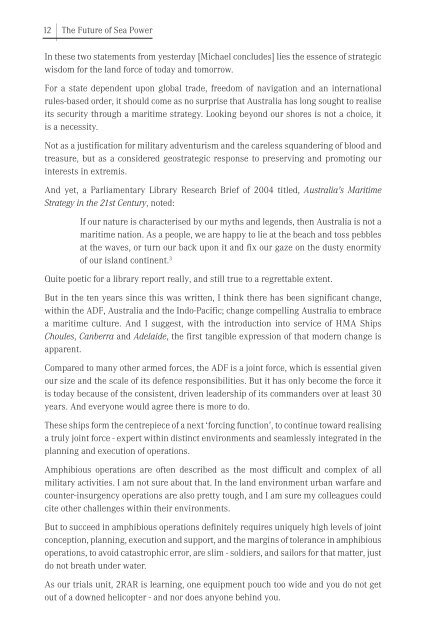THE FUTURE OF SEA POWER
SPC2015_Proceedings
SPC2015_Proceedings
Create successful ePaper yourself
Turn your PDF publications into a flip-book with our unique Google optimized e-Paper software.
12 |<br />
The Future of Sea Power<br />
In these two statements from yesterday [Michael concludes] lies the essence of strategic<br />
wisdom for the land force of today and tomorrow.<br />
For a state dependent upon global trade, freedom of navigation and an international<br />
rules-based order, it should come as no surprise that Australia has long sought to realise<br />
its security through a maritime strategy. Looking beyond our shores is not a choice, it<br />
is a necessity.<br />
Not as a justification for military adventurism and the careless squandering of blood and<br />
treasure, but as a considered geostrategic response to preserving and promoting our<br />
interests in extremis.<br />
And yet, a Parliamentary Library Research Brief of 2004 titled, Australia’s Maritime<br />
Strategy in the 21st Century, noted:<br />
If our nature is characterised by our myths and legends, then Australia is not a<br />
maritime nation. As a people, we are happy to lie at the beach and toss pebbles<br />
at the waves, or turn our back upon it and fix our gaze on the dusty enormity<br />
of our island continent. 3<br />
Quite poetic for a library report really, and still true to a regrettable extent.<br />
But in the ten years since this was written, I think there has been significant change,<br />
within the ADF, Australia and the Indo-Pacific; change compelling Australia to embrace<br />
a maritime culture. And I suggest, with the introduction into service of HMA Ships<br />
Choules, Canberra and Adelaide, the first tangible expression of that modern change is<br />
apparent.<br />
Compared to many other armed forces, the ADF is a joint force, which is essential given<br />
our size and the scale of its defence responsibilities. But it has only become the force it<br />
is today because of the consistent, driven leadership of its commanders over at least 30<br />
years. And everyone would agree there is more to do.<br />
These ships form the centrepiece of a next ‘forcing function’, to continue toward realising<br />
a truly joint force - expert within distinct environments and seamlessly integrated in the<br />
planning and execution of operations.<br />
Amphibious operations are often described as the most difficult and complex of all<br />
military activities. I am not sure about that. In the land environment urban warfare and<br />
counter-insurgency operations are also pretty tough, and I am sure my colleagues could<br />
cite other challenges within their environments.<br />
But to succeed in amphibious operations definitely requires uniquely high levels of joint<br />
conception, planning, execution and support, and the margins of tolerance in amphibious<br />
operations, to avoid catastrophic error, are slim - soldiers, and sailors for that matter, just<br />
do not breath under water.<br />
As our trials unit, 2RAR is learning, one equipment pouch too wide and you do not get<br />
out of a downed helicopter - and nor does anyone behind you.


